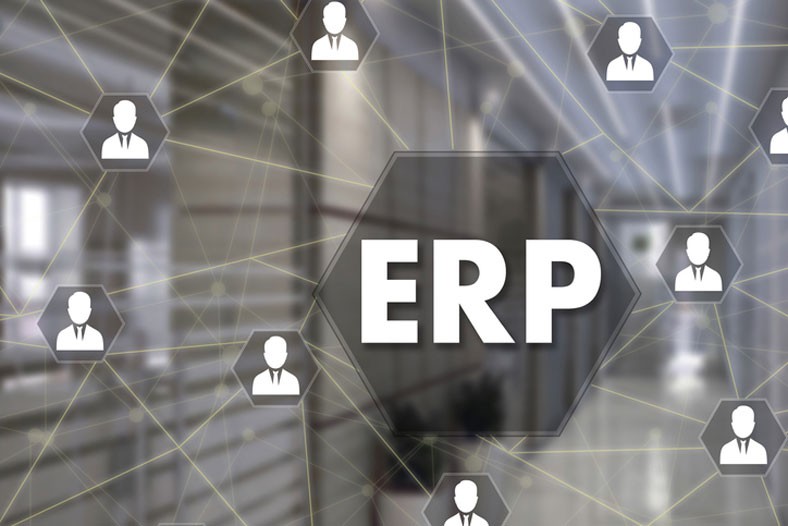
Wherever you show up for work in the morning in logistics today, the first thing you do is log in to your supply chain software system. Also known as a Supply Chain Management System, or SCMS, these are applications that provide information technology tools for managing and running logistics services.
Whether it’s on a tablet in the job shack before you head out to walk the container stacks at a port waterfront, or on your monitor array in a corner office at corporate headquarters, there’s a good chance you are doing most of your daily tasks inside some kind of supply chain software.
Featured Programs:Sponsored School(s)
But there is a breathtaking variety of supply chain software solutions on the market today. Making the right choice for your organization isn’t easy. You need to get the lay of the land in the supply chain software world before you can hope to find the right fit.
Supply Chain Software Systems Are the Major Tool of Most Logistics Teams Today

Information technology is integral to running a modern organization. Whether you’re talking about accounting, HR, or shifting supplies and materials around a factory, software is a big part of how business gets done today.
Just as accountants and human resources teams have information systems tailored to their demands, supply chain professionals have a unique set of problems that requires unique software solutions. Everything from inventory management to compliance has a particular set of challenges.
But we also live in an age of alignment. Supply chain software solutions aren’t ideal if they don’t talk to other corporate software systems. Businesses have learned the hard way that systems that don’t integrate closely lead to duplication of entry, error, and inefficiency.
For the broad functions of supply chain management, siloed data that other departments can’t access can be catastrophic for business efficiency.
Finding software that both meets the daily requirements of logistics teams in the field, analysts in the back office, managers calling the shots from the upper floors, and all the various other teams and partners in the supply chain process is a tall order.
Anyone hunting down jobs in the supply chain management world today had better be well-versed in the options available for supply chain management software.
What Are the Different Kinds of Supply Chain Management Software in Use Today?

Supply chain software systems wear a lot of functional hats. A system that does inventory management might not have any risk management functions, for instance, and vice versa. But they also have some more fundamental differences to understand before you even get to the nuts and bolts of the functions they fill.
Differences in How the Supply Chain Software is Structured
It starts with something you might call the system paradigm. That is, how is the software envisioned as part of the larger management information system? You can find supply chain software offered as:
- Stand-alone software programs. These are designed and built from the ground up to work as a single system.
- Suites of core and optional modules that can be combined into a customized system. They have separate components to handle various aspects of the supply chain function.
- Plugins and modules for more comprehensive ERP (Enterprise Resource Planning) software systems. They act as suites, but their perspective is larger and supply chain management functions are only a small part of their features.
Differences in How the Supply Chain Software Is Sold
Next, there is the provisioning or purchase model of the software. Some programs are offered as a straight-up off-the-shelf product, a one-and-done purchase at a flat rate. Subsequent versions or support are charged separately on a case-by-case basis.
Others are sold on a subscription model, where an ongoing fee entitles you to new features and upgrades as part of the package for as long as you are subscribed.
Differences in Who Manages the Supply Chain Software
There’s also the hosting model. Many supply chain software companies today are offering cloud-based SCMS systems. Cloud services are hosted by the software company or another dedicated internet provider. All the data, application code, and processing happen in data centers owned and managed by the provider. They achieve cost savings through economies of scale, hosting your data and services alongside those of other clients. These require robust internet access, since that’s your only point of connection.

On the other hand, they can take a lot of information technology management overhead off your plate. The hosting company handles all the server software updated, storage issues, networking redundancy, and many other technical details that would otherwise fall to your IT team. Like using a 3PL provider, this helps keep your organization focused on the core functions.
There are also so-called private or hybrid clouds, which aren’t really cloud systems at all, but simply private-label servers hosting only your organization’s SCMS. While they remove some of the economics of large-scale cloud services, they may be more secure and more customizable.
Different Functions Are Managed by the Supply Chain Software
On top of those options, different supply chain management solutions focus on different functional aspects of supply chain work. In some cases, software exists to fulfill only a single, highly-specific function… inventory management, for instance.
In other cases, a single software program may encompass a group of related functions, like air and ocean freight forwarding.
And finally, particularly with modular supply chain management solutions, a software package can cover a wide range of tasks, customized to your organizational needs, but interconnected through data and workflow. The big ERP solutions offered by heavyweights like Oracle and SAP serve as the operating system for entire global corporations. The data flowing through them is the lifeblood of operations and planning. Supply chain modules are just a tributary in the great stream of information that executives use to steer the entire enterprise.
What to Look for in Supply Chain Software Solutions

Many of the advantages to putting a supply chain management system in place are obvious. In fact, it’s hard to do business in logistics today without one.
As a lever for market advantage, though, it’s important to not only implement an SCMS, but to adopt one that aligns with your strategic needs. That can mean not only finding the right functionality in the software, but also programs that plug in seamlessly with other corporate systems, and the systems that outside logistics partners use.
It can also mean finding software that doesn’t come with a lot of bells and whistles that you won’t need.
What Are Supply Chain Management Solutions Pitfalls to Watch For?
As key as these software packages can be in delivering efficiency and productivity improvements, they also come with additional complications for supply chain managers.
Excessive Complexity Creates Risk
Every extra configuration option that you don’t use, every piece of data collected that is never used, every screen that is laid out in a format that doesn’t match your operations flow is a chip in your overall efficiency.
Additionally, these can create new security vulnerabilities in your company that didn’t exist before. Every potential entry point or data that can be lost is a new item your IT security and risk management folks must deal with.
Software Silos Reduce Utility
Related to dead-ends in extensibility is the risk of software lock-in. Supply chain software is almost always proprietary code. Data and workflow created in it isn’t always easy to export to plug into software from another vendor. That keeps you from getting maximum value from your supply chain by requiring duplicate entry or other inefficient workarounds.
If you’re happy with the current solution, that’s no problem. If you’d prefer to move on, it can get very expensive. That creates impediments to switching systems, which in turn can lead to vendors getting lazy with updates and improvements.
Open-Source Supply Chain Management Software Solves Several SCMS Problems
 Organizations looking for more control over both cost and price in supply chain management software solutions are turning in the same direction that other industries have gone – open-source solutions.
Organizations looking for more control over both cost and price in supply chain management software solutions are turning in the same direction that other industries have gone – open-source solutions.
Open-source software isn’t always free, but it is designed to be highly customizable. With code that is always available, there are no mistakes about how it works or what it can do. And any organization that needs unique features or support to fuel a competitive supply chain advantage can pay to put those features into their system without leaning on big vendors with other priorities. There’s no lock-in to worry about.
Open source also has another advantage, which is, counter-intuitively, better software supply chain security. With open codebases, there’s little room for hackers to compromise systems without someone spotting the vulnerability.
Open-source software isn’t known for a high level of polish. But as with other SCMS solutions, some of the more impressive open-source options are now run as cloud-based services by outsourcing providers. These come with points of contact and support that rival those offered by other SCMS vendors.
How to Develop Expertise Working with Supply Chain Management Solutions

It’s impossible to find a degree in supply chain management and logistics today that doesn’t include coursework on software for supply chain management.
In fact, you can even find some programs that offer a major in Supply Chain and Information Systems. In other cases, a school’s SCM degree may be offered through the information technology department. That offers additional IT expertise built-in to the degree, even if it doesn’t say so on the label.
Also important is the comprehensive approach that a college education takes in putting SCMS solutions together with supply chain concepts and functions. You’ll get the important practical training in how to use the software, but you’ll also learn about the underlying processes, projections, and activities that the software is designed to support.
College is really just the start of your journey toward mastering supply chain software solutions, though.
Supply Chain Software Companies May Offer Certification in Using Their Systems

Particularly when you get into the massive ERP systems, vendor certification comes into play for both technical and professional reasons.
Certification is a process that often wraps up some specific training courses, examinations, and often a verification of relevant experience too. Unlike educational certificates, these professional certifications validate your knowledge and skills for the very specific needs of the software packages they cover.
On the technical side, a certification offers training, often directly from the vendor, on the unique features of their system. It’s a stamp of approval showing you’ve mastered the details of a complex software package.
For professional purposes, holding a supply chain software company certification tells potential employers that you have mastered the software that they need you to know.
In many cases, these certifications are offered separately for different aspects of the program… covering just procurement, for instance.
Regardless, you’ll have to do some homework on your own to keep up with the state-of-the-art in supply chain management software solutions.
The Big List of Supply Chain Management Software

We’ll get you started with a massive list of supply chain management software. These different types of supply chain management software include packages that are highly specialized to specific applications and various industries. Some represent niches and vendors that you may never have heard of; others will be heavyweights like Netsuite and Oracle.
In many cases there is overlap between categories. A package that handles risk management might also, by its nature, assist with optimization. Visualization packages are also necessarily analytics packages. And, of course, many big SCMS cover the whole board with their capabilities.
Supply Chain Planning Software
Planning software often incorporates demand forecasting, modeling, and analytics features to help managers lay out targets for production, inventory, or shipping capacity. It allows analysts and executives to align all supply chain operations to support expectations and strategic plans. Some supply chain planning software handles big-picture planning and scheduling, while other packages drill down into specific aspects like manufacturing, maintenance scheduling, or stock allocation.
Supply Chain Execution Software
SCE describes a category of SCMS that can include any sort of execution-oriented application… warehouse management, transportation management, or other functions that handle the daily business of shifting and storing goods. Some innovative supply chain execution software providers, like Shippabo, mix software and services—their platforms can be used to work with internal or 3PL shipments, or as a part of forwarding services offered by the company itself.
Supply Chain Visibility Software
Visibility is one of the holy grails of SCMS, and visibility software concentrates on it above all else. Visibility software solutions tap into insights from corporate data that offers details of in-transit shipments, financial arrangements, order details, and performance data. Visibility software frequently relies on data interchange and other SCMS systems to draw on for reporting and exposure.
Supply Chain Risk Management Software
SCRM is a field that has been in the spotlight ever since COVID-19 struck. It’s not surprising that many specialized software solutions have emerged to help get a handle on it. These packages help visualize geographic, financial, and legal vulnerabilities in your supply chain. Some offer advanced ESG compliance, while others may help monitor and manage current risk events.
Supply Chain Optimization Software
Like supply chain risk management software, optimization software packages use analytics to identify elements of your supply chain that could be restructured for greater efficiency. These programs also may create models and simulations to show the impact of different kinds of restructuring.
Supply Chain Analytics Software
Supply chain analytics software delivers the tools and perspectives to take in raw data and take apart trends and events for new insights. Reporting on every element of supply chain operations and surfacing new trends and insights is the purpose of this software.
Supply Chain Collaboration Software
Collaboration software is so common in business today that it barely rates a mention. But on top of common project management and communication platforms like Slack or Microsoft Teams, you’ll find programs that are built specifically to connect logistics teams both within a company and with external vendors. These systems keep everyone on the same page through every step of the logistics process.
Supply Chain Compliance Software
Compliance covers any kind of regulatory or social norm adherence needed to keep supply chains above-board. From avoiding suppliers with a history of abusive employment practices to making sure tax forms are filed on time, compliance software automates your organization’s due diligence.
Supply Chain Forecasting Software
Forecasting software in supply chain circles can mean anything from ocean weather reports to sales expectations. But in all cases, it’s important data that supply chain managers need to fuel their decisions for production, shipping, and storage allocation.
Supply Chain Finance Software
It’s rare for financial software to not take in the overall financial and accounting picture of an organization, but there are a few packages that focus on the financial needs specific to the supply chain. These often focus on leveraged procurement processes and cash flow management through the supply chain process.
Supply Chain Mapping Software
Getting a visual picture of the physical path of your goods as they flow through the supply chain is a valuable tool for executives and managers. Often combined with compliance, modeling, or risk management services, these packages offer fast, easily understood pictures of how your products and materials are moving and highlight areas most in need of attention.
Supply Chain Modeling Software
Supply chains today are some of the most complex systems on the planet. Modeling software helps build a digital version of your real-world connections, which makes it easier to visualize and understand how materials and products are moving through the system.
Supply Chain Simulation Software
Like modeling software, simulation supply chain software creates a digital representation of your supply chain and allows scenario planning and comparison without changing your current real-world networks at all. It’s useful for developing a variety of different plans and contingencies based on different conditions.
Supply Chain Sustainability Software
Closely related to compliance, sustainability software products evaluate procurement and operations practices. Supplier data is fed to create scorecards and risks. Waste and carbon emissions tracking can help provide a picture of both CSR and compliance risks.
Healthcare Supply Chain Software
The healthcare industry has a unique supply chain with special regulatory and safety requirements. That has led to specialized healthcare supply chain software packages, both as part of larger hospital management systems like Cerner that come with inventory and other plugins, and stand-alone products like symplr Spend, analyzing medical technology and devices to optimize healthcare supply chain procurement.
Supply Chain Management Software for Small Business
Small business supply chain management software has to thread a tough needle: pricing has to be right, but the features need to fit the wide range of supply chain tasks a small company requires. Players both large and small in the ERP and SCMS space have options, as do more general packages like CRM and accounting packages for small businesses that may include logistics features.
Retail Supply Chain Software
Retailers have unique inventory and stocking challenges, with long lead times and production needs. That makes them another area where specific software design can be a big boost to supply chain management and oversight. Retail modules are offered by some big ERP players like Oracle, while dedicated providers like Shopify focus on even more specialized retail SCM in e-commerce.
Food Supply Chain Software
Food suppliers have a product base that is extremely safety and time-sensitive. Supply chain management is the difference between a truck full of fresh onions and spoiled produce that no restaurant or consumer will touch. Food SCMS cover their bases by emphasizing track and trace capabilities with quality monitoring issues to ensure that freshness and safety requirements are met with every delivery.







